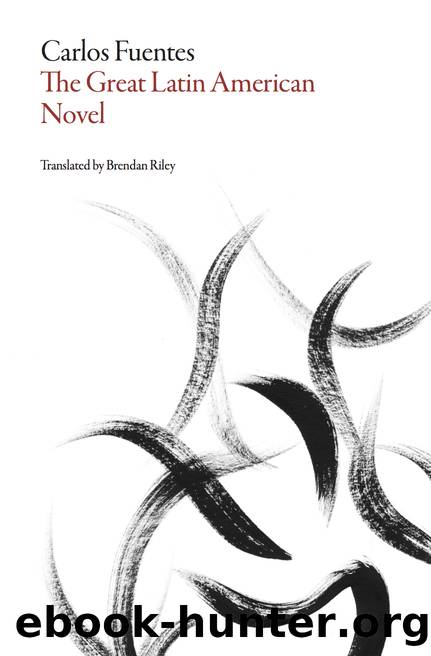The Great Latin American Novel by Carlos Fuentes

Author:Carlos Fuentes
Language: eng
Format: epub
Publisher: Dalkey Archive Press
Published: 2017-01-15T00:00:00+00:00
3. COUNTERCONQUEST AND BAROQUE
The epiphanies in Paradiso occur by means of a departure for the distant world of the ârealistâ stage, a direct transit from the order of causality to the order of what is hidden, latent, possible or forgotten, that aesthetic of intuition of which Guillermo Sucre speaks. It is a poetic path, arduous at times, but one which obeys the writerâs profound conviction: cultures are his imagination. Lezama Lima suggests that we divert the emphasis placed on the history of cultures in favor of âimaginary eras.â What is understood by this? âIf a culture,â he writes in The Bewitched Quantity, âdoes not manage to create some kind of imagination,â it will become, with the passage of time, âbrutally indecipherable.â For that reason, he proposes a history of humanity âdivided by eras corresponding to their potential to create images.â
In The American Expressionâone of the great explorations of our continentâs culture, along with those written by Sarmiento, Reyes, MartÃnez Estrada, and MariáteguiâLezama imagines the times of Ibero-Indo-African America following their incarnation in the Pre-Hispanic myths, the âdouble astonishmentâ of the Conquest, the colonial Baroque, the âcalabooseâ of independence and the popular culture of the nineteenth century. As I have mentioned, Lezama observes a succession from the indigenous storyteller to the Spanish chronicler, and from this the Baroque señor, the exiled romantic and the master of the landed estate. But the nineteenth century fixation on this last element is set in motion once again by popular culture: the Mexican charro, the Argentine gaucho: chattered and gossiped about, celebrated in story and song, in corridosâpopular balladsâthat are recorridoâsung and told over and over again, far and wideâculminating in a new image: the work of José Guadalupe Posada, who in turn announces another new movement, still without name, because it is ours, the name for what we are now.
Julio Ortega is correct when he calls Lezama âthe least traumatized theorist of Latin American culture, which he understood as a solution of continuities, always as a realization, never as a problem.â But Lezamaâs sense of continuity is quite distinct from remoteness or a non-definition. Quite the contrary; it means an effective, corporeal, dynamic approach to each phase of the cultural continuity or âimaginary erasâ of our lands. But these same adjectives already indicate to us that, among all these moments of the imagination, Lezama is most addicted to one, the Baroque, and he employs it not only as an intellectual preference but more precisely as a form of his artistic creation.
In the end, both reference and form are reunited because Lezama is also a Catholic writer, and if his Baroque aesthetic demands an artistic incarnation, it simultaneously demands moral, philosophical, and spiritual reason. Immersed in the Catholic civilization of Spanish America (Counter-Reformist and closed to modernity), Lezama searches with lucid desperation for a way out, closer than the insipidity of pious Catholicism and holy cards, beyond our contemporary identification of modernity with Protestant capitalism, even as we cover ourselves, nonetheless, with a cape of
Download
This site does not store any files on its server. We only index and link to content provided by other sites. Please contact the content providers to delete copyright contents if any and email us, we'll remove relevant links or contents immediately.
The Power of Myth by Joseph Campbell & Bill Moyers(1014)
Half Moon Bay by Jonathan Kellerman & Jesse Kellerman(954)
Inseparable by Emma Donoghue(937)
A Social History of the Media by Peter Burke & Peter Burke(936)
The Nets of Modernism: Henry James, Virginia Woolf, James Joyce, and Sigmund Freud by Maud Ellmann(836)
The Spike by Mark Humphries;(766)
The Complete Correspondence 1928-1940 by Theodor W. Adorno & Walter Benjamin(749)
A Theory of Narrative Drawing by Simon Grennan(742)
Culture by Terry Eagleton(724)
Ideology by Eagleton Terry;(696)
Bodies from the Library 3 by Tony Medawar(683)
World Philology by(678)
Farnsworth's Classical English Rhetoric by Ward Farnsworth(674)
Game of Thrones and Philosophy by William Irwin(671)
High Albania by M. Edith Durham(659)
Adam Smith by Jonathan Conlin(648)
A Reader’s Companion to J. D. Salinger’s The Catcher in the Rye by Peter Beidler(647)
Comic Genius: Portraits of Funny People by(616)
Monkey King by Wu Cheng'en(611)
